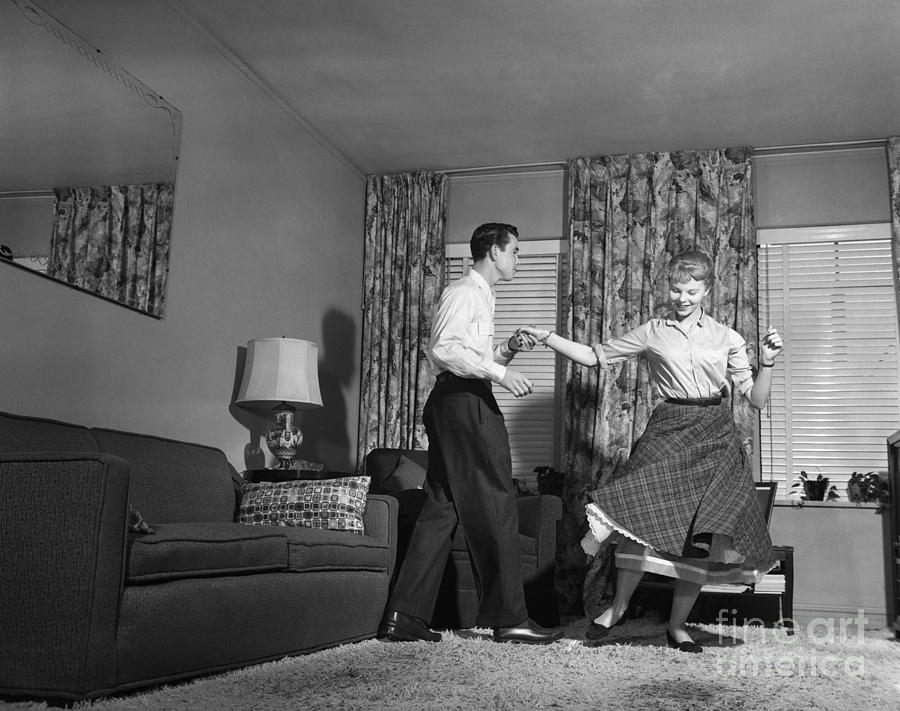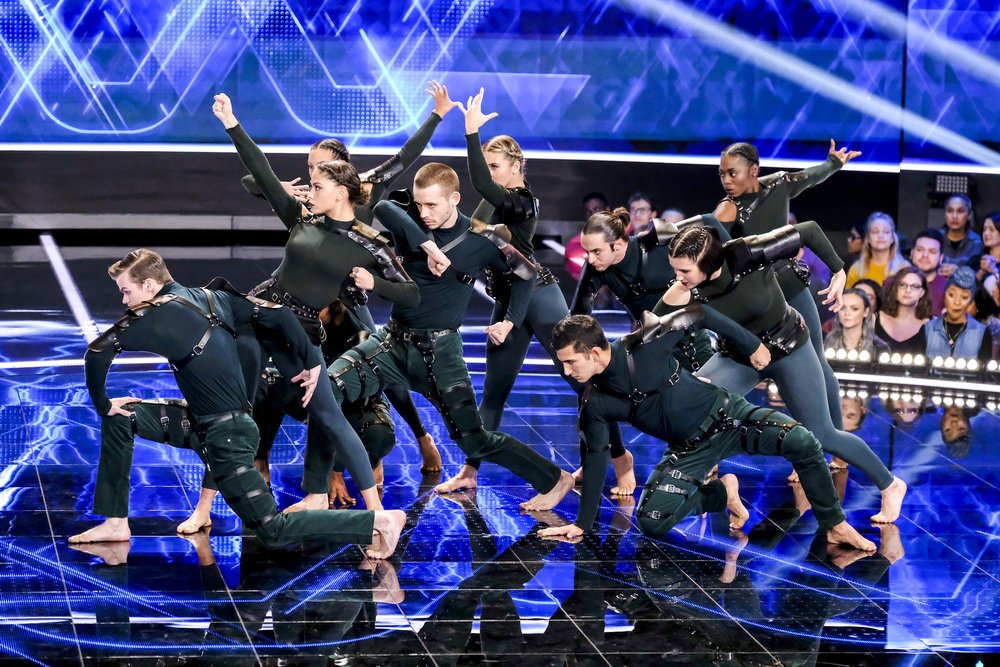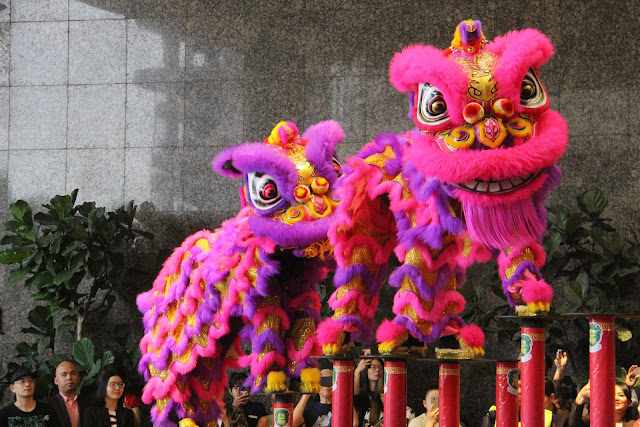How to do 50s dances
The most loved 1950s dance styles
The fabulous 1950s represent a real watershed in the history of dance: the dances of the decade were fun and innovative and reflected the evolution of the times.
The spread of television allowed millions of viewers to see their favorite songs performed for the very first time, and consequently also pick-up the dance steps that accompanied them.
It is precisely for this reason that certain dances acquired an unprecedented popularity, dances such as Rock’n’Roll (a teenage evolution of the Jitterbug and Swing dancing), the Madison, the Stroll, and the Hand Jive.
Here is an overview of the most popular music and 1950s dance styles.
1950s Music for dancing
The 1950s represented an exciting period for music, and consequently music for dancing was rich and manifold and provided a diverse soundtrack for the most popular dances of the decade.
Musical styles evolved rapidly with the birth of Rock‘n’Roll, and inevitably dance styles developed and varied to adapt to the changes in the music. The presence of a TV set in every family home also provided young people with the opportunity to learn new dance styles very quickly.
- Swing
Swing became popular and achieved commercial success at the end of the 1920s as a somewhat diluted evolution of Jazz. It experienced its height of popularity in the 1930s and 1940s (suitably referred to as ‘The Swing Era’) with the rise of Big Band Dance Orchestras, led by and featuring both black and white musicians.
In the 1950s however, the popularity of Big Bands and Swing music declined, and while some Big Bands continued to find work as studio orchestras for TV or radio productions, essentially they became the backing bands to a new (and considerably less swinging) ‘Pop’ sound. Vocalists took centre stage and singers such as Frank Sinatra, Dean Martin, and Judy Garland stepped into the spotlight.
- Jazz
In New Orleans at the end of the 19th Century, ‘Founding Father’ Buddy Bolden alongside fellow Afro-American musicians fused together ragtime, blues and gospel sounds and improvised rhythms during performances to create a brand new genre of music – Jazz. Jazz has remained popular in its various guises and evolutions for well over a century.
Throughout the 1920s, 1930s and 1940s it inspired many new styles and genres including Swing and Bebop, and at the beginning of the 1950s Jazz entered its ‘Cool’ phase. The music was calmer, more loungey, and featured softer and longer melodies. By the end of the decade however, some musicians began to reject the traditional norms and structures of Jazz in favour of an improvisational and experimental ‘free-jazz’ style (which would later become known as Avant Garde Jazz). Lester Young, Charlie Parker, Dizzy Gillespie, Miles Davis, John Coltrane, and Nina Simone were some of the most popular Jazz artists of the 1950s.
- Blues
Blues is thought to have originated in the Southern States of America after the American Civil War, however like Jazz, it wasn’t really documented until the turn of the 20th century. Also like Jazz, its roots are thoroughly African-American. This lyrical yet melancholic genre of music inspired many different styles from Delta Blues to Country Blues to West Coast Blues.
In the 1950s the Blues infiltrated the ‘mainstream’. The mass migration of African-Americans after the end of World War II and a general nationwide increase in income helped the Blues travel out of rural areas and into cities like Chicago and Memphis. Some styles favored the harmonica (blues harp), and others the electric guitar (electric blues), and some styles got labeled as ‘Rhythm & Blues’. Iconic artists of the decade included the likes of Muddy Waters, B.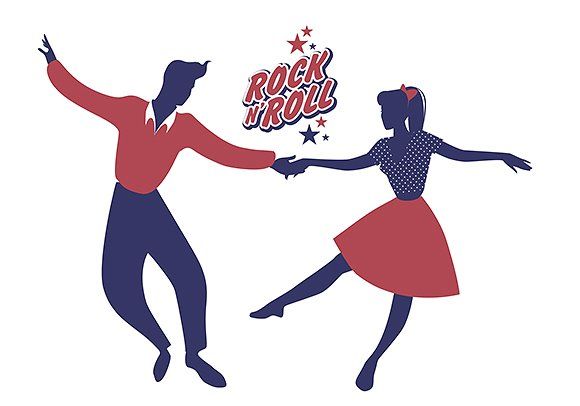 B. King, John Lee Hooker, Chuck Berry, T-Bone Walker, Howlin’ Wolf, Willie Dixon, Jimmy Reed and Bo Diddley.
B. King, John Lee Hooker, Chuck Berry, T-Bone Walker, Howlin’ Wolf, Willie Dixon, Jimmy Reed and Bo Diddley.
- Rock’n’Roll
Rock’n’Roll was essentially an amalgamation of several musical genres: primarily Blues, Country and Bluegrass, and also Jazz and Gospel. Thanks to artists like Chuck Berry, Little Richard, Jerry Lee Lewis and the King of Rock’n’Roll himself, Elvis Presley, the genre had an immediate impact on the lives of its listeners.
Rock’n’Roll in the 1950s (and indeed today) was not just a musical genre, it was a lifestyle and represented a new way of looking at the world. It affected families, it influenced behaviour, language, politics, inspired fashion, and even influenced the Civil Rights movement. It’s rhythm and format is distinct and yet at the same time distinctly indefinable, thanks to its rich and manifold nature. Rock’n’Roll was a musical revolution that rocked the nation, literally.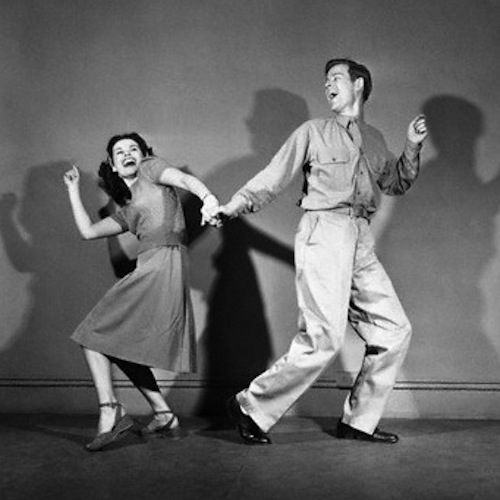
- Rockabilly
Rockabilly is a musical genre that developed around the beginning of the 1950s in the southern United States. Its name blends ‘Rock’n’Roll’ and ‘hillbilly’, and the style of music is often categorized as a sub-genre of Rock’n’Roll with heavy Country music influences and links to Bluegrass, Jazz, Boogie Woogie and Rhythm’n’Blues.
The early recordings of Elvis Presley alongside many of the ‘Sun’ artists in the early 1950s were considered to be ‘Rockabilly’. The bands were small and usually limited to a couple of guitars and a double bass, accompanied of course by vocals. The recordings were rough and ready and the vocals often added that Country twang. Unlike Rock’n’Roll and Swing however, Rockabilly featured predominantly white artists such as Carl Perkins, Johnny Cash, Sonny Burgess and Jerry Lee Lewis.
- Caribbean Craze
It would be remiss not to mention the Latin American music craze that hit the 1950s hard with Mambo, Cha Cha Cha, Rumba, and Calypso rhythms infiltrating the airwaves and even diffusing into the Rock’n’Roll and Pop music of the day.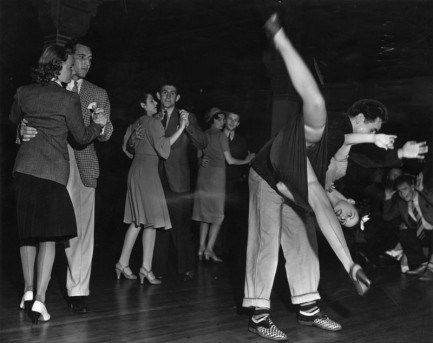 The lively Cuban rhythms and rich musical sounds made for great dance steps and popular artists included Pérez Prado, Tito Puente, Xavier Cugat and Tito Rodrìgues.
The lively Cuban rhythms and rich musical sounds made for great dance steps and popular artists included Pérez Prado, Tito Puente, Xavier Cugat and Tito Rodrìgues.
The most famous and popular 1950s dance styles
The world of 1950s dance reflected the evolution of the times: they were innovative, enthusiastic, and fun, just like the 1950s.
Partner Dances
Rock’n’Roll
Rock’n’Roll is pretty much a blanket term for all of the dances that were danced to rock’n’roll music in the 1950s. The terminology can be confusing, as there were so many dance variations from State to State, and even from ballroom to ballroom, and on top of that, modern usage of some dance terms have a whole different meaning altogether today. So while it’s understandable that definitions of the dances will vary, it can be said that the Swing dances of previous years undeniably developed and evolved to the new rhythms and powerful beats of Rock’n’Roll during this revolutionary decade.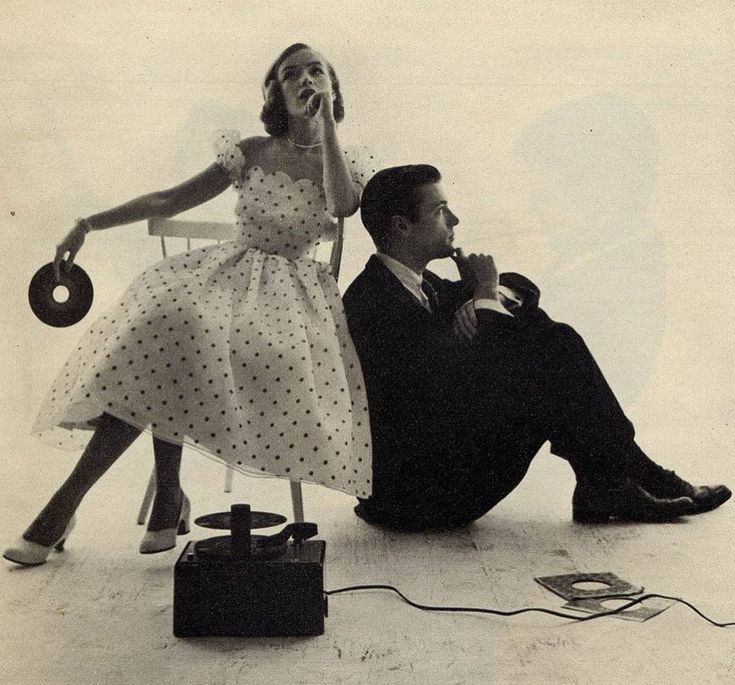
Jitterbug (also known as Jive)
The term Jitterbug dates from the 1930s, and referred to both the dancer and the dance. However it is generally agreed that the dance was a simplified version of the Lindy Hop, featuring fewer steps, and therefore making it easier to dance to faster music. As a dance it transitioned very easily from Swing to Rock’n’Roll music, and films such as Rock Around The Clock and Rock, Rock, Rock showcased the dance to a new generation of younger dancers eager to get on the floor.
Boogie Woogie
Boogie Woogie music was particularly popular in the 1920s, however the dance originated and flourished in the 1950s in direct response to Rock’n’Roll music. Like the Jitterbug, it has its roots in Swing, and is another off-shoot of the Lindy Hop. While it is certainly adept to Boogie Woogie piano rhythms, it is also associated (although not exclusively) with energetic, driving up-tempo rocking tunes.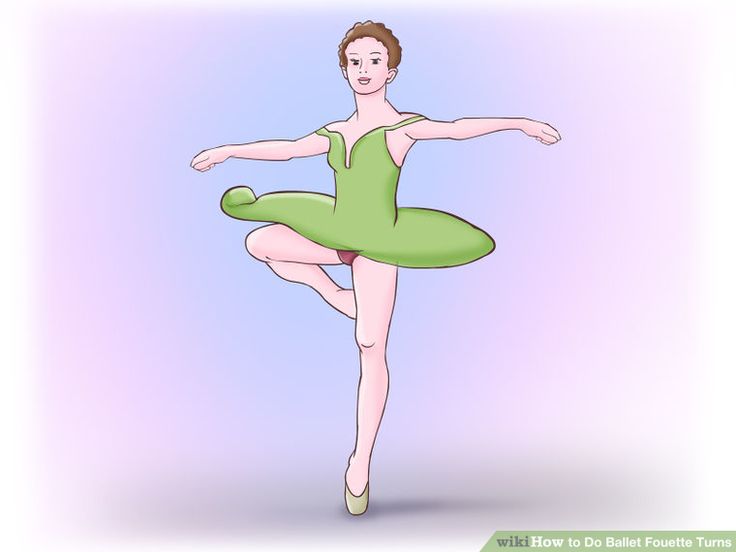 In the 1950s this dance variation would probably just have been known as ‘Rock’n’Roll’, however what we call Boogie Woogie today is also sometimes referred to as East Coast Swing.
In the 1950s this dance variation would probably just have been known as ‘Rock’n’Roll’, however what we call Boogie Woogie today is also sometimes referred to as East Coast Swing.
Learn to dance in “vintage style”, take a look at our Dance Academy. Start from scratch or rekindle an existing passion for dance with our internationally renowned teachers.
Calypso
As America went gaga for the exotic rhythms of the Caribbean in the 1950s, it goes without saying that interest in dances such as the Mambo, Rumba and Cha Cha Cha also increased. The ‘Chalypso’ is the name that the iconic broadcast American Bandstand gave to the simplified version of the Cha Cha Cha that was becoming popular amongst teenagers. It remained a partner dance, but was very simple and playful, and the steps were performed out of hold.
Novelty Dances
Bunny Hop
The Bunny Hop was a classic early 1950s party dance: it was energetic and full of jumps, but very simple and repetitive, which made it perfect for parties.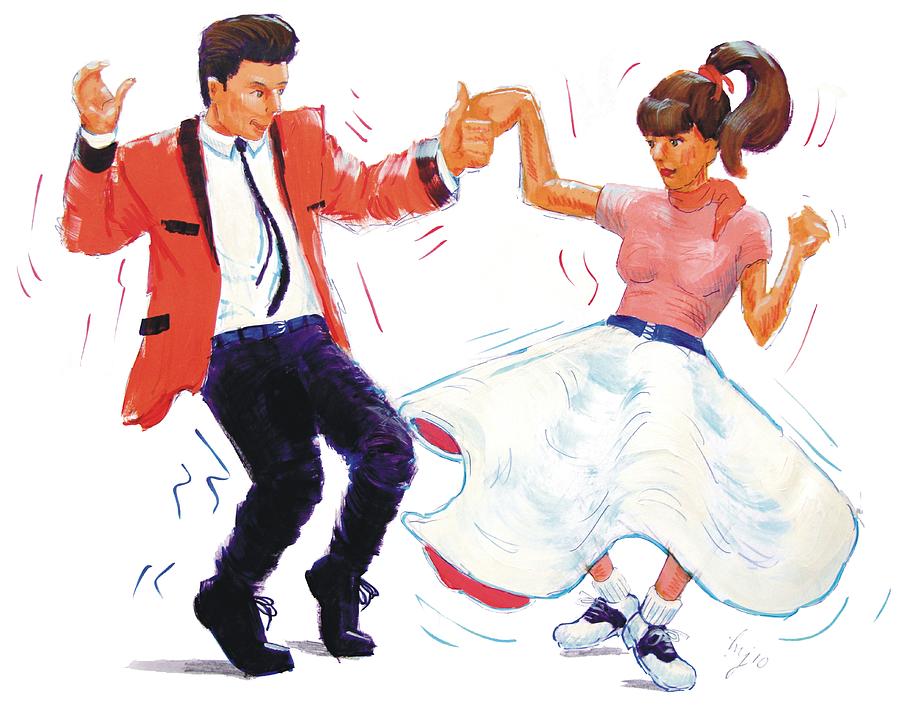 Dancers formed a line (imagine a conga line) and performed a short sequence of side-steps and jumps forward and back to the music. The dance routine featured on TV and even had its own song, with some versions including the instructions for the dance.
Dancers formed a line (imagine a conga line) and performed a short sequence of side-steps and jumps forward and back to the music. The dance routine featured on TV and even had its own song, with some versions including the instructions for the dance.
Hand Jive
In 1957 filmmaker Ken Russell recorded teenagers dancing the ‘Hand Jive’ in the basement of a London coffee bar. The venue was so crowded that there wasn’t enough room to actually dance properly, so they invented a rhythmic clapping choreography for their hands instead, which they could do without a partner and sitting down. It didn’t take long for the craze to reach the States and just one year later in 1958 American artist Johnny Otis had even recorded a song entitled ‘Willie and the Hand Jive’ with a notably recognisable Bo-Diddley riff.
Twist
Yet another novelty dance sensation in the 1950s was the Twist. Interestingly enough, just like the Hand Jive, songs were written in reaction to the dance craze that was inspired by and danced to Rock’n’Roll music, and not the other way round.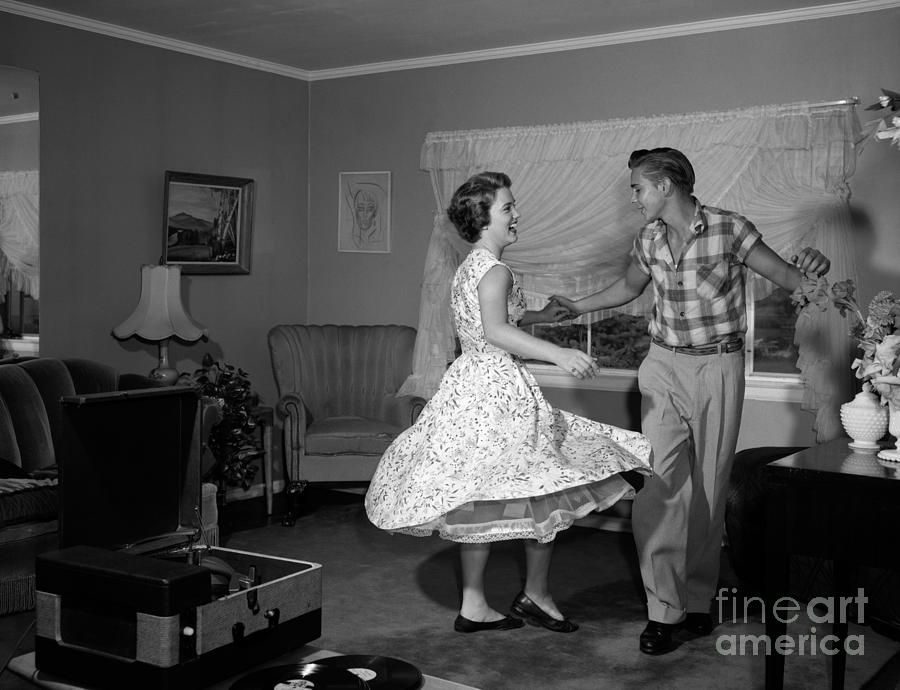 In 1959 both Hank Ballard and Chubby Checker released tracks entitled ‘The Twist’ after the dance had already caught on. The dance itself is very simple; it is performed alone (without a partner) and is based on the swiveling motion of the hips and ankles that have the effect of ‘grinding’ into the floor. The torso has limited movement and the arms mimic the swiveling action of the hips.
In 1959 both Hank Ballard and Chubby Checker released tracks entitled ‘The Twist’ after the dance had already caught on. The dance itself is very simple; it is performed alone (without a partner) and is based on the swiveling motion of the hips and ankles that have the effect of ‘grinding’ into the floor. The torso has limited movement and the arms mimic the swiveling action of the hips.
Group dances in 1950s
With the decline of Swing and Big Band Orchestras, dance halls in the 1950s experienced a moment of crisis. However American teenagers still loved to dance, and towards the end of the decade group dances experienced a wave of popularity (thanks in part to their appearances on television). It was something new and different from the more established partner dances, and they were generally simple and easy to learn, which made them perfect for younger dancers.
The Stroll
The original Stroll emerged in the late 1950s and consisted of a line of women facing a line of men, forming a passageway down which couples ‘strolled’ to the music before parting and joining the end of their respective lines again.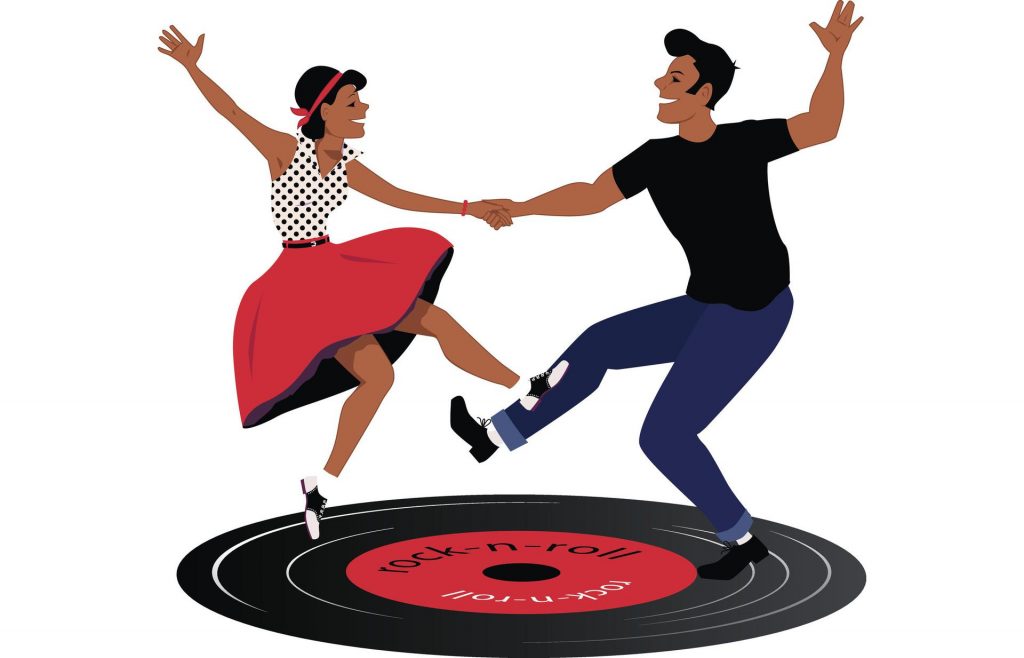 American Bandstand broadcast the dance being performed to the song of the same name by the group The Diamonds in 1957 and the rest, as they say, is history. The Stroll is still danced at events today but with significant variations from the original.
American Bandstand broadcast the dance being performed to the song of the same name by the group The Diamonds in 1957 and the rest, as they say, is history. The Stroll is still danced at events today but with significant variations from the original.
The Madison
The Madison emerged as a ‘line dance’ in the late 1950s in Ohio. It is danced without a partner, in lines on the dance floor, and follows a set choreography of steps and moves. In 1959 Ray Bryant released ‘It’s Madison Time’ in which the steps are called, and today the dance is commonly associated with this song. Like the ‘Twist’ and the ‘Hully Gully’, the dance went on to experience an even higher level of success in the 1960s after its appearance on television.
Hully Gully
The exact origins of the Hully Gully are unclear. History suggests that a dance called the Hully Gully dates as far back as the 1920s, however the dance referred to here is an ‘unstructured’ group dance that is commonly believed to date from 1959.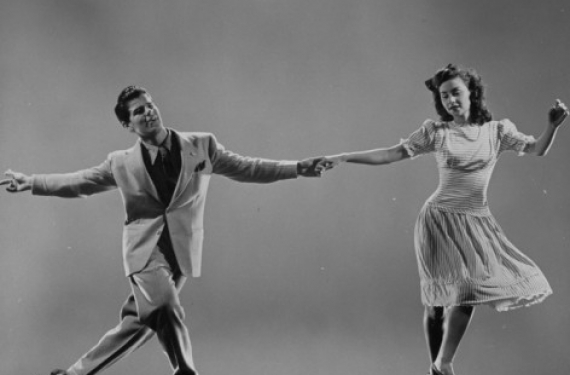 This coincides with the release of the song ‘(Baby,) Hully Gully’ by the Olympics that vaguely described the actions of the dance that include ‘shaking’ the shoulders and ‘wiggling’ the knees.
This coincides with the release of the song ‘(Baby,) Hully Gully’ by the Olympics that vaguely described the actions of the dance that include ‘shaking’ the shoulders and ‘wiggling’ the knees.
In Conclusion
The music and 1950s dance styles are not just a thing of the past.
Rock’n’Roll is alive and kicking, and thanks to the millions of people all around the world that are captivated by the rhythms, dances, fashions, and living history of that incredible and world-changing decade, the music and 1950s dance styles are more alive today than ever.
It is a chapter of history that remains open, and continues to give joy at dance events all around the world.
Learn to dance in “vintage style”, take a look at our Dance Academy. Start from scratch or rekindle an existing passion for dance with our internationally renowned teachers.
Dancing in the 50s
Dancing in the 50sRock and Roll dancing is actually swing dancing. East Coast Swing, West Coast Swing, Jive and Jitterbug, all came to be known as some type of Rock and Roll dancing, mostly thanks to the movie industry and the general media. So in reality, the music was Rock and Roll, and various forms of swing were used to dance to it.
East Coast Swing, West Coast Swing, Jive and Jitterbug, all came to be known as some type of Rock and Roll dancing, mostly thanks to the movie industry and the general media. So in reality, the music was Rock and Roll, and various forms of swing were used to dance to it.
From it's beginnings, rock and roll has been associated with dancing. Teen dances in the '50s fell into two categories: slow and fast. With slow dances couples held each other close and moved slowly around the dance floor in a type of box step. Fast rock and roll dances usually took the form of the Jitterbug, a holdover from the big band swing of the '30s and '40s. Again couples touched, if only by hand, and engaged in a variety of fast steps that could include considerable virtuosity and gymnastics.
The rock and roll music of the fifties was extremely easy to dance to because it had a steady, straight forward beat. The extraordinary uninhibited nature of the music prompted even the most insecure or self-conscious listener to feel they could join in on the action.
The dancing that evolved in response to rock and roll is of black origins. The link between the music and the movement, the music's commanding ability to make the listener get up and dance, are a sign of its black origins.
"Neither the music, the song, nor the dance stands alone in African-American culture"
Benita Junta Brown
While the Jitterbug has clearly traceable roots in African-American culture, many other dances that teenagers created to rock and roll songs during the fifties were invented by blacks. Though whites may have popularized them, the dances were often based on steps and body movements of blacks.
Juke Joints
Many of the places teens hung out at in the fifties, such as ice cream parlors, bowling alleys, roller rinks and diners had jukeboxes with the latest rock and roll records.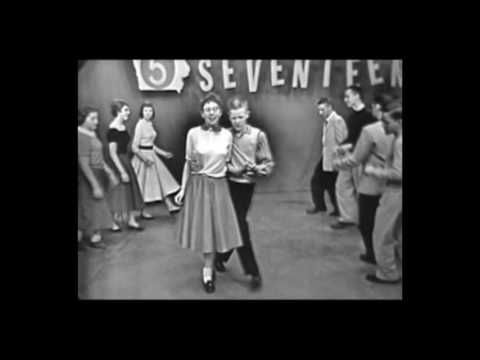 These jukeboxes were coin operated that played the 45 rpm records that the teen selected. Someplaces, such as a restaurants, had a small, compact tableside device that teens could use the select songs to here as the waited to place their orders and/ or as they ate. Juke joint is not to be confused by the jook joint which was a black music and dance places that emerged just after the Civil War, usually in the rural South.
These jukeboxes were coin operated that played the 45 rpm records that the teen selected. Someplaces, such as a restaurants, had a small, compact tableside device that teens could use the select songs to here as the waited to place their orders and/ or as they ate. Juke joint is not to be confused by the jook joint which was a black music and dance places that emerged just after the Civil War, usually in the rural South.
Sock Hops
One of the places that rock and roll dancing developed was at the local sock hop. The name was given because dances were often held in the local school gyms. Since hard-soled shoes weren't allowed to be worn on the gym's varnished wooden floors, the dancers had to remove their shoes and dance in their shoes. Thus the term became synonymous with record hops and was widely used for any of the 50s rock and roll dance parties. It was here that allowed the creation, observation and practice dances. It is also why in their earliest forms dances were highly regionalised.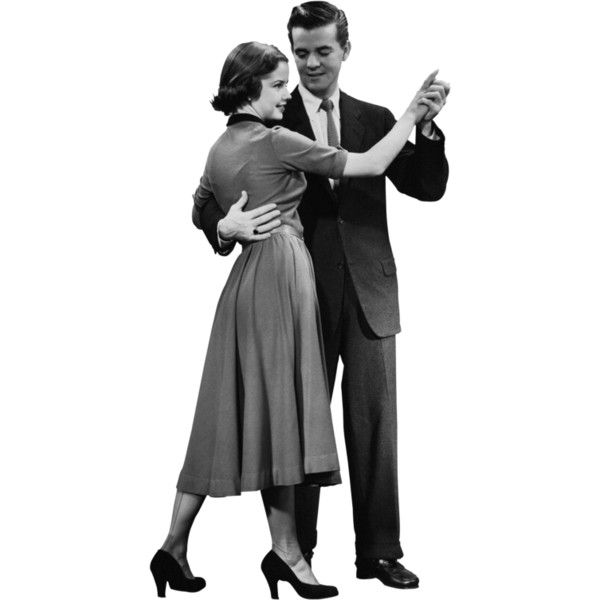
Slow Dancing
The dance they did was a slow version of the Slow Fox Trot. Eventually fifties teens did away with almost all of the Fox Trot's traveling figures and foot patterns. They simply stood in place, holding tight to their partner and gently swayed stepped forward, to the side, back and to the side in a box pattern.
The guy put his right hand around the girl's waist. His left hand lightly held hers at shoulder level. The girl's left hand was on his shoulder, while her right hand was clasping his.The guy lead going forward, while the girl followed, moving backward.
The Fish
The Fish was was an updated version of a dance from the early 1900s, the Slow Drag.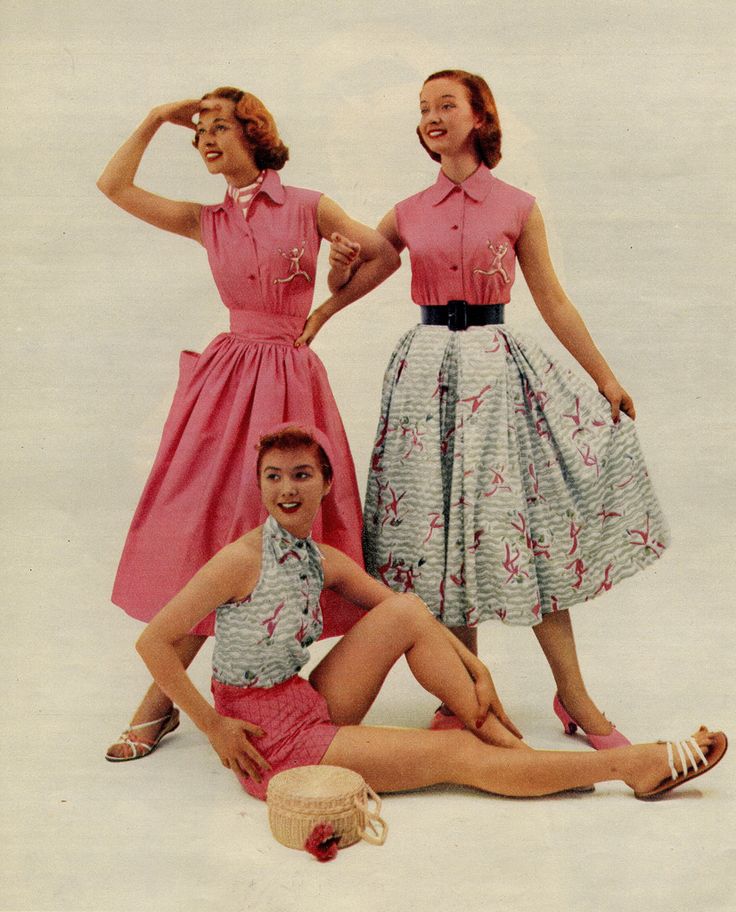 in which couples would hold on the each other and grind against each in one spot. When stepping forward forward, the dancer was to drag the left foot. When stepping back, it was the right foot that would be dragged. Moving sideways to the right, the dancer would drag the left foot and and moving sideways to the left, the dancer would drag the left foot.
in which couples would hold on the each other and grind against each in one spot. When stepping forward forward, the dancer was to drag the left foot. When stepping back, it was the right foot that would be dragged. Moving sideways to the right, the dancer would drag the left foot and and moving sideways to the left, the dancer would drag the left foot.
Boogie Woogie
As a dance style, Boogie Woogie encompassed any kind of swing dancing done fast and was also called "Jump Swing." The Boogie Woogie was usually danced to blues and Boogie Woogie music with fast tempos. This type of fast dancing included jumps, hops, stomping, and even flying feet, all done at considerable speed.
The Bunny Hop
The Bunny Hop became a classic party dance in the early 1950s. Originally, it was danced to the Bunny Hop by Ray Anthony, which came out in 1952 and include all the instructions for what to do. To do the Bunny Hop, all you need is energy to hop away and preferably some people to form a conga line with.
To do the Bunny Hop, all you need is energy to hop away and preferably some people to form a conga line with.
Jitterbug
Jitterbug is an offshoot of the Lindy Hop, a high energy athletic dance that was started by blacks at Harlem Savoy Ballroom in the late 20s. The dance developed in the thirties as competing couples tried to outdo each other with more challenging moves with awe-inspiring speed and energy. In the thirties "jitterbug" was a term that given to the raucous swing music fans. In the early forties, jitterbug was applied to the modified version of the Lindy that people were dancing to the latest swing tunes.
The Jitterbug is a spot dance meaning it does not travel around the floor. The basic step is a syncopated two-step that accentuates the off-beat, followed by a "breakaway" which is the characteristic feature of the dance. It is during the "breakaway" that the dancers get to show off their original moves.
The Jitterbug makes use of three versions of a six-count basic step. Though it is always in a 2/4 or 4/4 time.
Though it is always in a 2/4 or 4/4 time.
The term "jitterbug" was originated in the early '30s, and eventually, it came to be use as an umbrella term to refer to swing in general. Movies like "Rock Around The Clock," "Rock, Rock, Rock," and the "Girl Can't Help It" include Jitterbug dancing in them. By the late 1950s, youth began calling fast dancing by the name. It's easy to learn to do the Jitterbug.
The Jitterbug Basic is counted in six counts of music, but there are only four steps.
How to do the Jitterbug
1) Begin facing your partner with your hands clasped gently in front of you. 2) Press into one another's hands to propel your bodies back. 3)The lead should step back with his left foot, while the follower steps back with her right. 4. Pull one another's hands gently to move closer together, stepping forward with the opposite foot. Together, steps two and three are called the rock step. 5) The leader steps and leans to the left while the follower steps and leans to the right.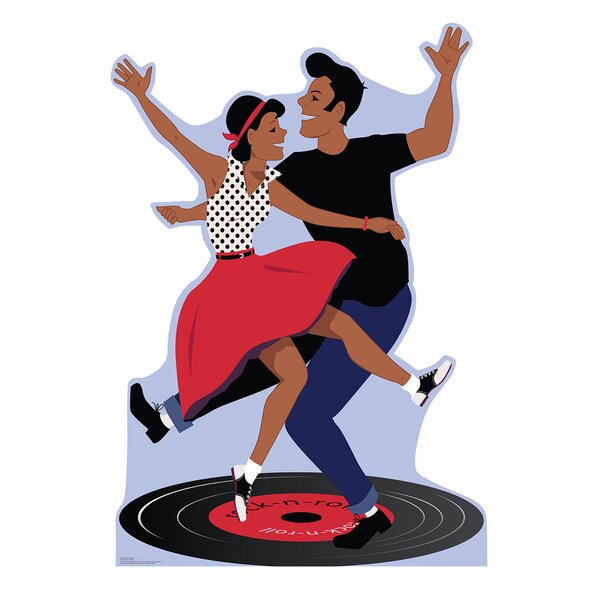 6) The leader steps and leans to the right while the follower steps and leans to the left. Repeat steps two through five as many times as desired at a pace of quick, quick, slow, slow
6) The leader steps and leans to the right while the follower steps and leans to the left. Repeat steps two through five as many times as desired at a pace of quick, quick, slow, slow
The Jive
The Jive, like the Jitterbug, is a variation of swing dancing. Its origin is American, it has strong Latin and African American influences, and it is known for being fast and fun. The Jive is now one of the official Latin American dance forms in the competition arena, and it is danced the world over in rockabilly joints.
How to do the Jive
The basic Jive dancing step consists of eight weight changes in six beats. Whoever is leading performs a rock step (one foot step back, other foot replace it) for the first two counts. Then, the couple chasses to the left for counts 3 and 4. Chasse to the right for counts 5 and 6, and then you are dancing the Jive! The dance is simple and jovial, and it is a favorite in many American competitions and exhibitions today.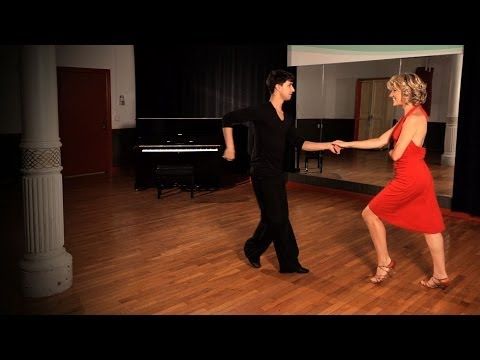
The Cha-Cha
Originally hailing from Cuba, the Cha-Cha is danced to many more songs than just Latin music. The basic step is easy enough; the follower simply mirrors the steps of the lead.
How to do the Cha-Cha
Standing in a closed dance frame, the lead steps forward with the left foot, shifting weight onto it Immediately shift the weight back onto the right foot, doing what's
known as the "rock step" Bring the weight back up to the left, quickly bringing the right foot up next to the left Do another quick weight shift to the right foot, then back to the left (this is the "cha-cha-cha") At the original tempo, shift your weight onto the right as it steps forward Rock back onto the left, and bring the right foot back for another fast "cha-cha-cha" step
Dancers repeat this basic step in between several more complex moves that can be executed by the dancers. Like the other 50s dance moves here, the Cha-Cha can be a dance unto itself or just a quick move to put into any choreography where the music fits.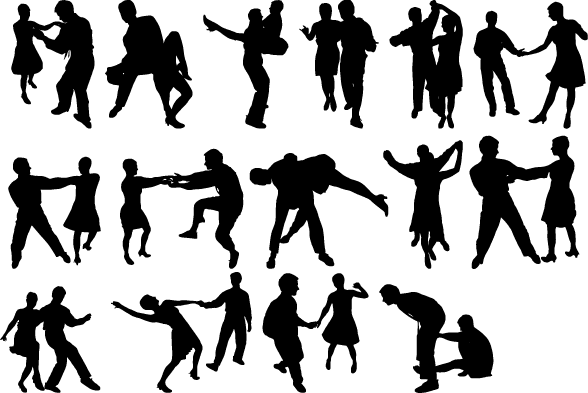
Hand Jive
The Hand Jive the most clear cut example of the synchronized, choreographed dance of the fifties and perhaps the easiest to do was the Hand Jive. The hand Jive can be done standing up, facing a partner. standing one assumes a slightly hunched over, bent knee position so that your thighs and shoulders are relatively close. This also the makes it easier to do the quick moves.
This dance was made most famous by the movie Grease. The original song was created by Johnny Otis and enjoyed its greatest popularity during the summer of 1958. You can see Otis singing it on YouTube along with his dancers. While they do more complex moves, the basic hand jive can be done using a simple jazz square foot movement accompanied by the following hand motions:
The Hand Jive consists of a series of small gestural actions performed in a steady rhythm, with each move falling directly on the beat of the music.
How to do the Jive
1) Crouch down and slap your palms against your thighs twice. 2) Cross your palms over and under each other, like a referee announcing "safe!" 3) Make your hands into fists and pound them on top of each other, twice each. 4) Use your fingers to touch elbows, one at a time "Hitch-hike" by making fists with your thumbs sticking out and pointing them over your shoulder, again twice on each side
2) Cross your palms over and under each other, like a referee announcing "safe!" 3) Make your hands into fists and pound them on top of each other, twice each. 4) Use your fingers to touch elbows, one at a time "Hitch-hike" by making fists with your thumbs sticking out and pointing them over your shoulder, again twice on each side
The Madison Line Dance
Dancing the Madison in the Broadway musical Hairspray
Photo Courtesy Joan Marcus/Photoplay
The most intricate of the fifties choreographed group dances was the Madison. It is generally agreed that the Madison originated with Midwestern blacks and was appropriated by white teens nationwide.
In the late 1950s and early 1960s, the Madison line dance gained great popularity. A simple-to-follow dance line and steps that were called for the dancers made it a huge success. The Madison craze spawned several recordings of songs specifically made for the dance with Al Brown's "The Madison" and Ray Bryant's "Madison Time" competing neck in neck on Billboard's Top 40.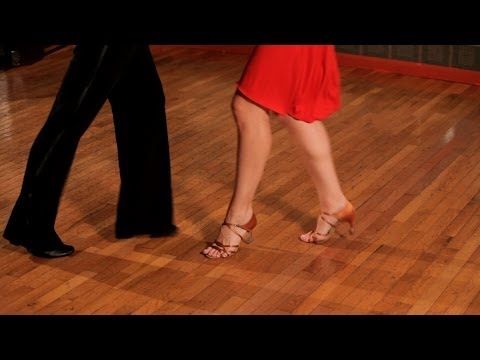 It was so popular that in 1988 the movie Hairspray featured the dance, and it has become one of those recurring features in movies and series depicting 1950s popular dances.
It was so popular that in 1988 the movie Hairspray featured the dance, and it has become one of those recurring features in movies and series depicting 1950s popular dances.
How to do the Madison
The Madison is done in parallel, horizontal lines with everyone facing forward. Done to music with a 4/4 meter it consists of a six count basic step that is interspersed with idiosyncratically variations that are preformed in response to the caller. The basic step includes six distinct movements, each done on one beat of the music a touch of the left foot as it reaches diagonally across the right, a touch of the left foot out to the left side, another touch of the left foot diagonally across the right, a step forward on the left on the left touch, a touch of the right foot directly next to the left and a backward step on the right. Hand claps or finger snaps are sometimes added on the fifth count
The Slop
The men would put there hands in their pockets and yank up their pants legs as if showing off their shows.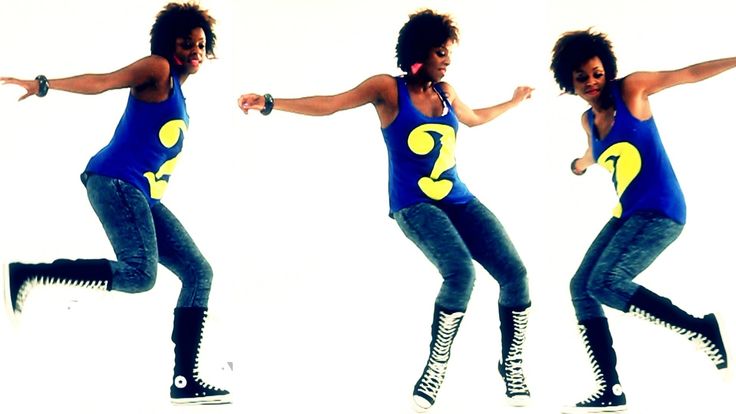 It was danced to a moderate tempo and was done without touching your partner. basic step featuring a shoulder dip and backward diagonal kick, as well as variations that involved swiveling on the balls of the feet and twisting around done by crossing one foot behind the other and making a complete turn. It wasn't danced on Bandstand
It was danced to a moderate tempo and was done without touching your partner. basic step featuring a shoulder dip and backward diagonal kick, as well as variations that involved swiveling on the balls of the feet and twisting around done by crossing one foot behind the other and making a complete turn. It wasn't danced on Bandstand
Philadelphia Dances
Just because many new dances were introduced on Bandstand, kit is not correct to assume that those dances were created by Bandstand teens. Many of the Bandstand teens got a lot of there moves, steps and styles from watching black teens. Black teen dancing in Philadelphia could be watched on the Milt Thomas show, often described as the black Bandstand. Originally broadcast from Wilmington, Delaware before it moved to a studio in Suburban Station in center-city Philadelphia, it was named after its host, Mitch Thomas.
The Stroll
The Stroll, Bandstand early 59
Photo courtesy Library of Congress
One of the most popular dances of the 50s, the Stroll was a dance popularized on American Bandstand.
The stroll was introduced on the show by Chuck Willis. The Stroll is a group dance dance done in two parallel. lines , with boys on one side the girls on the other, facing each other. The basic step is a 12-count movement phrase, which is actually a 6-count phrase simply repeated on the other side. the boys start with the left foot, the girls with the right. beginning with the feet together, the boy's side with a left diagonal step ( count 1)and then with a touch of the left foot as it drags as it drags back into place next to the right (count). Next comes a forward diagonal step out onto to the left (count 3) followed by a step onto the right that as it cuts tightly behind the left (count 4) The phrase finishes with a step to the side with the left foot (count 5) and a tough, next to it with the right (count 6). The entire sequence is then repeated with the right foot
The other element is the solo stroll by each couple. While the two lines perform the basic step, a couple formed from the boy and girl at the far end of the line ( the end that is towards the boy's right and the girl's left) dances together down the middle.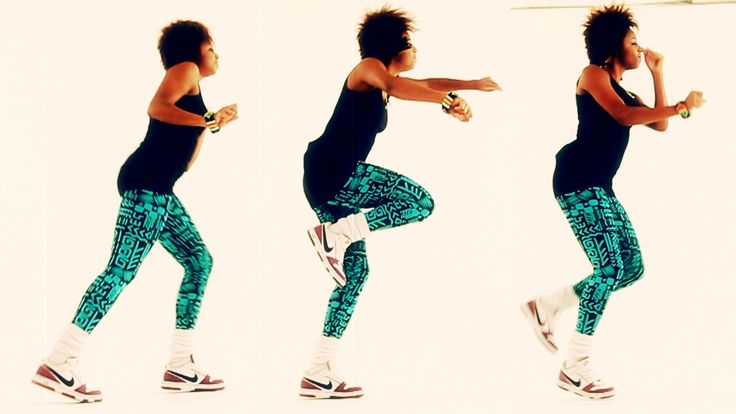 The pair can then take the opportunity to improvise their steps or execute a forward traveling variation of the basic Stroll step. When the couple reaches the end of the lane, they split apart and replace the boy and girl at the end of the line., as a new couple forms at the opposite end.
The pair can then take the opportunity to improvise their steps or execute a forward traveling variation of the basic Stroll step. When the couple reaches the end of the lane, they split apart and replace the boy and girl at the end of the line., as a new couple forms at the opposite end.
How to Stroll
The basic move for the Stroll gradually moves the dancer, foot by foot, up the line until he gets to the very front, at which point the two partners abandon the basic and do their own "shine" dance down the center aisle with everyone clapping and appreciating them.
For Him
Step forward on your left foot. Slide your right foot up even. Move your right foot to the right. Slide your left foot over to meet it. Step back on your right foot.
Slide your left foot back to meet it. Move your left foot to the left. Slide your right foot over to meet it and return to the original position.
For Her
Step back on your right foot.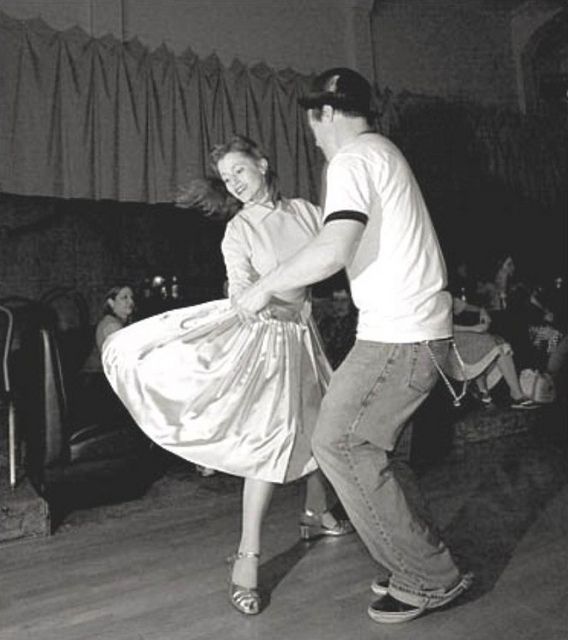 Slide your left foot back even. Move your left foot to the left. Slide your right foot over to meet it. Step forward on your left foot.
Slide your left foot back even. Move your left foot to the left. Slide your right foot over to meet it. Step forward on your left foot.
Slide your right foot forward to meet it. Move your right foot to the right. Slide your left foot over to meet it and return to the original position..
The Walk
Was done in a Conga line-like formation, with dancers one behind another, holding on to the waist of the person in front. It went around the room with a two-action movement first to one side than the other. the movement involved throwing out the same leg and arm, as the torso opened up to the side and chugging forward slightly on the other leg as the working leg returned to its original position
The Cha-lypso
The Cha-lypso was a combination of the Cha-Cha and the Calypso. Near the end of the '50s, American Bandstand came up with a name for the simplified Cha-Cha steps the teens were dancing to swing rhythms: the Chalypso.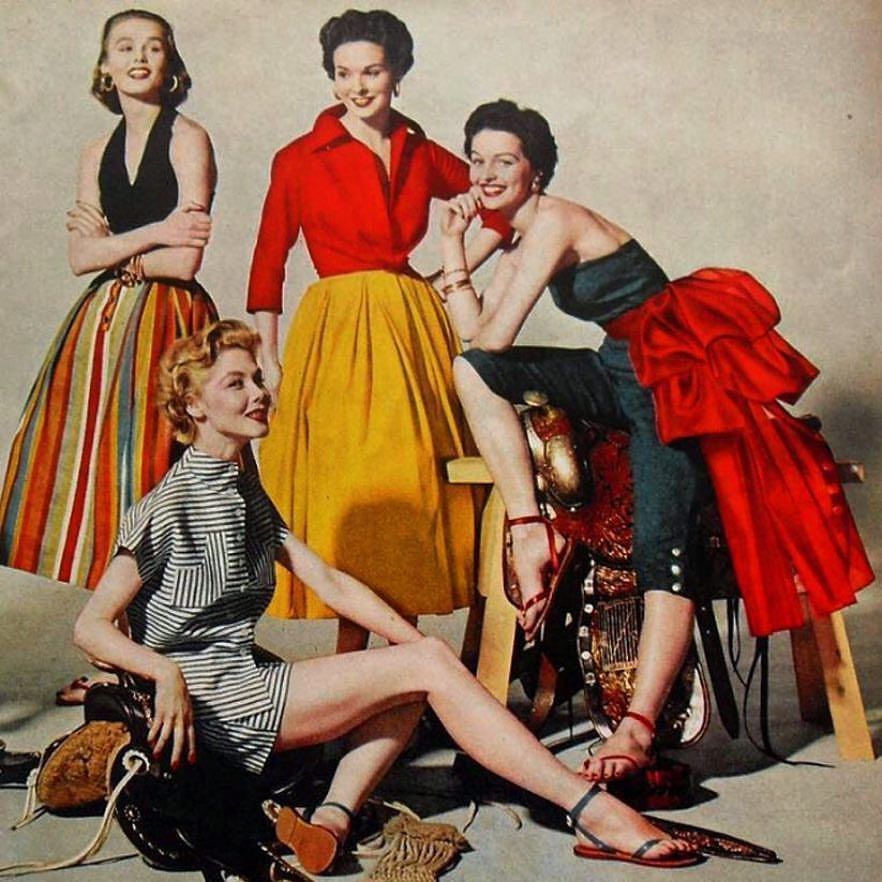 While Calypso songs were generally danced to with a mix of Rumba and Samba steps. Somewhere down the line, it got watered down and reinterpreted as simplified cha-cha by the youth. This fun and easy dance style was ideal for dancing to mid-tempo swing songs - not too fast, not too slow.
While Calypso songs were generally danced to with a mix of Rumba and Samba steps. Somewhere down the line, it got watered down and reinterpreted as simplified cha-cha by the youth. This fun and easy dance style was ideal for dancing to mid-tempo swing songs - not too fast, not too slow.
The Bop
The Bop dance style derives from the Jitterbug and East Coast Swing in the 1950s, but it is not to be confused with the Bop a Lindy -based partner dance that was done by all ages in the black community started in the 40s. The 'Bop' term actually comes from Be-Bop, those fabulous jazzy tunes from the '40s; however, it was not danced to Be-bop but to much faster rockabilly, and rock 'n' roll songs of the era like those of Gene Vincent.
The Bop was the first rock and roll dance introduced on American Bandstand in the summer of 1957 by a visiting teenagers from California. The Bop used many of the same moves as swing, including partners moving around each other, but was usually done with almost no touching and much, much faster.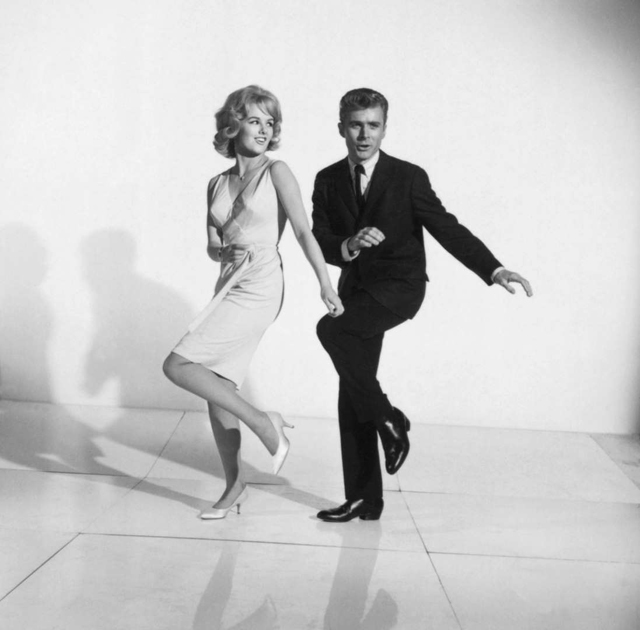 The Bop's more carefree, Charleston jumpy-like moves and independent dance style also encouraged dancers to go solo.
The Bop's more carefree, Charleston jumpy-like moves and independent dance style also encouraged dancers to go solo.
Dancing the bop entailed jumping up and down as if on a pogo stick and grinding your heels into the floor each time you landed. It's done with a partner but without holding hands. the bop was a dance from southern California that was being done gene Vincent's Be-Bop-A-Lula
The Philly Bop consisted of a basic jitterbug like step with a breakaway that allowed the partners to improvise steps. The partners stayed together musically by maintaining the rhythm and basic step. As the dance went on there were transistions back and forth between the basic step and the improvisational breakaways. Hence this dance was called the Bop.
The Twist
Photo from 1961 movie Hey, Lets Twist
Photo courtesy Paramount Pictures/Photofest
Like virtually all American dances, the Twist has it's origins in black culture. the Twist that became that became a sensation was an altered version of the original dance. The Twist was actually a combination of modifications of two earlier Ballard songs who teens danced to with torso twisting motions. According to Ballard, the dance was derived from the spontaneous twisting motions that his band were doing while playing their instruments They'd Twist their bodies while they would also lift one of their legs in the air. It was these observations that inspired Ballard to write a song about doing the Twist.
the Twist that became that became a sensation was an altered version of the original dance. The Twist was actually a combination of modifications of two earlier Ballard songs who teens danced to with torso twisting motions. According to Ballard, the dance was derived from the spontaneous twisting motions that his band were doing while playing their instruments They'd Twist their bodies while they would also lift one of their legs in the air. It was these observations that inspired Ballard to write a song about doing the Twist.
The dance that consisted of revolving their hips in quick, half-circle jerks, so their pelvic regions were heaving in time to the music. White teenagers first saw the dance performed at a Ballard concert in Baltimore. From there they took it to various ten dance shows among them American bandstand and the Buddy Dean Dance Show.
There are two difference version of how Clark became aware of the Twist. The first one was that Buddy Deane brought it to Clark's attention.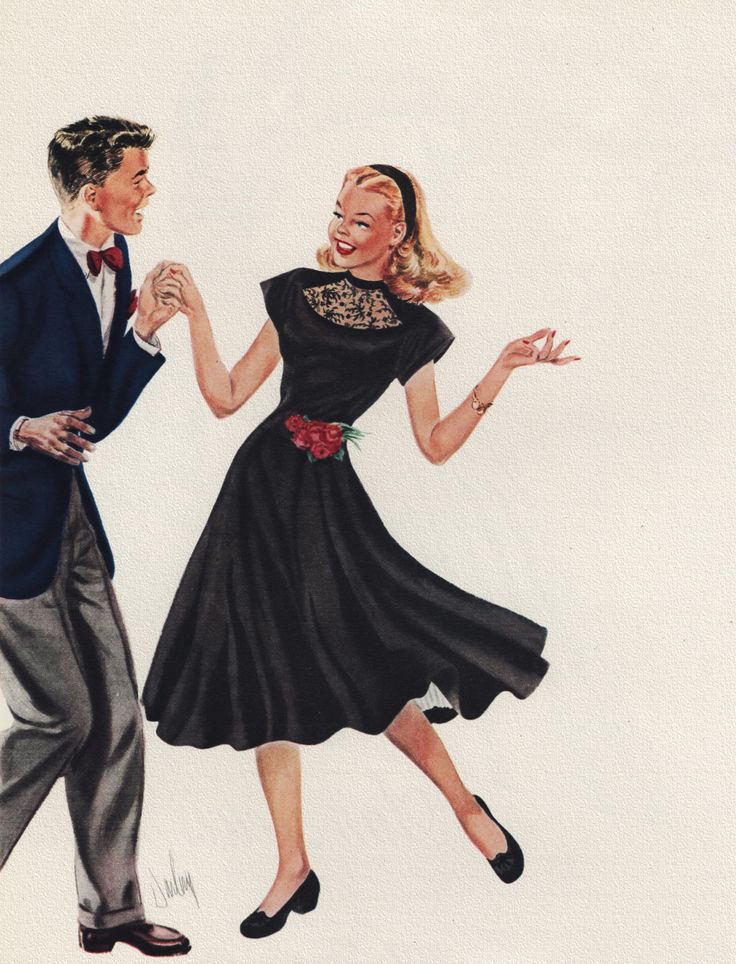 He told of how innovated it was that the teens were dancing to it without touching their partners. That it was sung by Rhythmn and Blues singer Hank Ballard whose songs were fully of rique double entendres.ballard was not the type that clark would have on his show and turned deane down.
He told of how innovated it was that the teens were dancing to it without touching their partners. That it was sung by Rhythmn and Blues singer Hank Ballard whose songs were fully of rique double entendres.ballard was not the type that clark would have on his show and turned deane down.
In Clark's version he claims he saw a black couple doing it on American Bandstand. He descibed what they were doing as " revolving their hips in quick, half-circle jerks, so their pelvic regions were heaving in time to the music."
Initially Clark would't allow it to be danced on the show because it was "too sugggestive" for his show, but white teenagers were fascinated by it and started imitating it. Clark eventually gave-in to them.
Clark thought it was 'too black' but once he committed to promoting it he went to his friend Bernie Lowe the owner of Cameo-Parkway Records and asked for a cover version. The singer was to be the mild mannered, pudgy singer Ernest Evans who Clark's wife re-named him Chubby Checker. "The Twist" was the beginning explosion of dance oriented records. "The Twist" is unique in rock and roll history, becoming a #1 hit on two separate occasions (September 1960 and January, 1962). The song and dance became a national fad, spinning off countless twist records for Checker and others
"The Twist" was the beginning explosion of dance oriented records. "The Twist" is unique in rock and roll history, becoming a #1 hit on two separate occasions (September 1960 and January, 1962). The song and dance became a national fad, spinning off countless twist records for Checker and others
Checker doing the Twist
Photo courtesy Photofest
Checker's Twist had no leg lifts but danced with both feet on the ground., one slightly ahead of the other and with knees bent. pretend you are wiping your bottom and putting out a cigarette with both feet. some jerky movements of the arms keeping waist level moving in opposition to your partner, occasionally lift one arm overhead and gesturing as swing a lasso.
Peppermint Lounge circa 1961
photo courtesy Bettmann/CORBIS
Unlike the other rock and roll dances of the fifties, which were signs of teen culture the Twist crossed over to the adults. You could find it being done at places such as the New York nightclub Peppermint Lounge. House dancers were the Dolly Sisters who would later become better known as the Ronettes. The House band The Starlighters contained the core of musicians that would evolve to be come first the Young Rascals and later simply the Rascals. There you could find both celebrities as well as the working class doing the Twist.
You could find it being done at places such as the New York nightclub Peppermint Lounge. House dancers were the Dolly Sisters who would later become better known as the Ronettes. The House band The Starlighters contained the core of musicians that would evolve to be come first the Young Rascals and later simply the Rascals. There you could find both celebrities as well as the working class doing the Twist.
Dance in the style of the 50's - History Of Dance
Dance of the 1950's
Dance in the style of the 1950's is a true reflection of the evolution, innovation and fun that characterized that era. With steps that evolved from swing, like the jitterbug and bop, and moves that anyone could do, like the bunny hop and walk, 50s dance style isn't going anywhere. Whether you're rockabilly ready or heading to the nearest rockabilly club, here are a few styles you might want to try.
Boogie-woogie
As a dance style, boogie-woogie included any kind of fast swing dance and was also called "jump swing".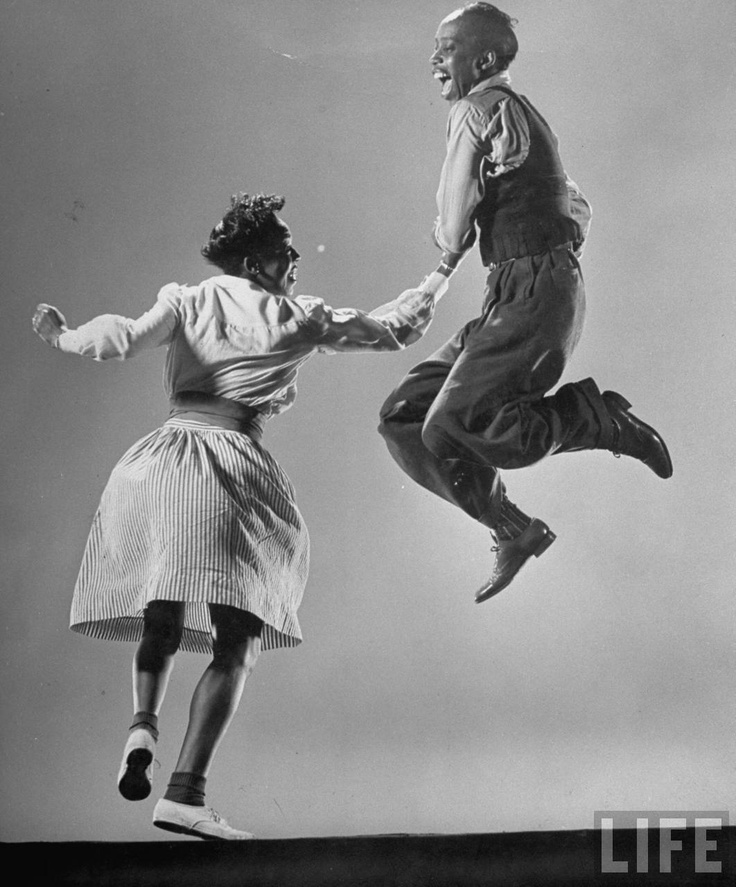 Boogie-woogie was usually danced to blues and boogie-woogie music at an uptempo. This type of fast dance involved jumping, bouncing, stomping, and even flying with the feet, all done at considerable speed.
Boogie-woogie was usually danced to blues and boogie-woogie music at an uptempo. This type of fast dance involved jumping, bouncing, stomping, and even flying with the feet, all done at considerable speed.
Related Articles
- Ballroom Dance Photos
- Dance Studio Equipment
- Photos of ballet dancers
Elvis Presley, Jerry Lee Lewis and other popular singers of the time developed their own version of rockabilly by combining blues and boogie-woogie. In Europe, people still dance boogie-woogie, although it has become close to jive and includes elements of both East and West Coast swing.
Bop
Bop dance style comes from the jitterbug and East Coast swing of the 1950s. The term "bop" actually comes from the word "bebop", those fabulous 40s jazz tunes; however, he did not dance to be-bop, but to the much faster swing, rockabilly, and rock and roll songs of the era, such as those of Bud Powell, Fats Waller, and Gene Vincent.
The term "bop" actually comes from the word "bebop", those fabulous 40s jazz tunes; however, he did not dance to be-bop, but to the much faster swing, rockabilly, and rock and roll songs of the era, such as those of Bud Powell, Fats Waller, and Gene Vincent.
The bop used many of the same movements as the swing, including partners moving around each other, but was usually performed with almost no touch and much faster. The more light-hearted, Charlestonian edgy moves and independent dance style of Bop also encouraged dancers to take up solos. English dance clubs were and still are filled with people doing bop.
Bunny jump
Bunny hop became a classic dance dance in the early 1950s. It was originally danced to Bunny Hop, Ray Anthony, which came out in 1952 and had all the instructions on what to do. Do a bunny hop, all you need is the energy to jump back and preferably a few people to form a conga line.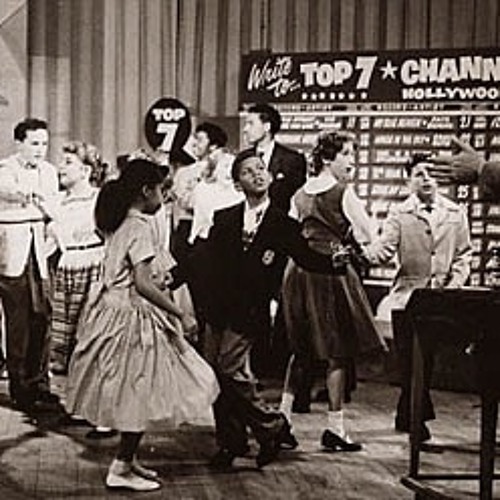
Chalypso
Toward the end of the 50s, the American stage came up with a name for the simplified cha-cha-cha steps that teenagers danced to swing rhythms: Chalypso. However, the dance style took its name from a string of Caribbean hits that took over the US by the end of the decade. At 19In 1956, Harry Belafonte released his Grammy Award-winning album Calypso , and many more Calypso releases followed with the album's success.
While Calypso's songs were usually danced with a mixture of rumba and samba steps. Somewhere in the future, this was watered down and reinterpreted by young people as a simplified cha-cha-cha. This fun and easy dance style was perfect for dancing to mid-tempo swing songs - not too fast and not too slow.
Jitterbug
The term "jitterbug" originated in the early 1930s and eventually came to be used as a general term for swing in general.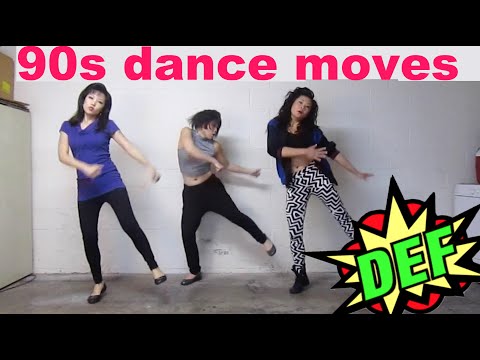 Movies such as Rock Around the Clock, Rock, Rock, Rock, and Girl Can't Help It feature the Jitterbug dancing. By the end of the 1950s, young people began to call fast dances by name. Learning how to Jitterbug is easy.
Movies such as Rock Around the Clock, Rock, Rock, Rock, and Girl Can't Help It feature the Jitterbug dancing. By the end of the 1950s, young people began to call fast dances by name. Learning how to Jitterbug is easy.
Jive
Jive, like Jitterbug, is a type of swing dance. His ancestry is American, heavily influenced by Latino and African American groups, and is known for his speed and fun. Jive is now one of the official forms of Latin American dance in the competition arena and is danced all over the world in rockabilly joints. Read more about the history of Jive dancing and detailed instructions here.
Madison Line Dance
In the late 1950s and early 1960s, the Madison line dance became very popular. The simple dance line and steps that the dancers were called upon were a huge success. Madison's madness spawned several recordings of songs specially created for the dance, featuring Al Brown's "Madison" and Ray Bryant's "Madison Time". Top 40 Billboard. It was so popular that the 1988 film Hairspray featured the dance, and it became one of those recurring features in movies and TV shows that depict popular dances 1950s.
It was so popular that the 1988 film Hairspray featured the dance, and it became one of those recurring features in movies and TV shows that depict popular dances 1950s.
To perform Madison, the dancers line up and follow the movements called the song. It's simple and fun!
Rock and roll
Rock and roll is actually a swing dance. East Coast Swing, West Coast Swing, Jive and Jitterbug have all come to be known as a form of rock and roll dance, largely through the film industry and the media. So it was really rock 'n' roll and various forms of swing were used to dance to it.
Some notable rock and roll songs include Gene Vincent's Be Bob a Lula, Little Richard's Tutti Frutti, Bill Haley's Rock Around the Clock, Chuck Berry's Johnny Be Goode and Great Balls. fire" by Jerry Lee Lewis. Some of the films that helped solidify rock and roll include Rockin' the Blues, Don't Knock the Rock, Rock, Rock, Rock!, Jailhouse Rock, The Girl Can.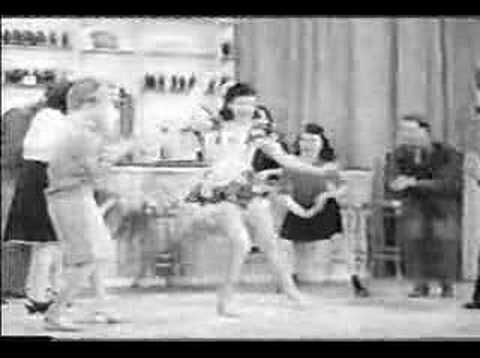 t Help It, "Indomitable Youth" and "Carnival Rock". Here is an example of a rock and roll swing:
t Help It, "Indomitable Youth" and "Carnival Rock". Here is an example of a rock and roll swing:
Walk
The walk was a staple of most dance halls in the 1950s. While this stress-free line dance was fun and easy, the Italian walk is just as easy today. This is a great way to showcase your best dance moves.
The 50s are here to stay
The fashion, fun dances and energetic revolutionary music of the 50s make this a cherished time for many. Try dancing in 1950s style and rock the night away with these steps to capture the magic of that era!
In rhythm with the head. How to learn to dance from scratch | People | SOCIETY
Elena Bezgodova
Estimated reading time: 6 minutes
3234
You can learn to dance at any age. /xusenru/pixabay.com
/xusenru/pixabay.com
What is not a season, then a new dance show on TV. Young dancers and well-established artists perform bizarre steps, at the same time talking about the fact that dance has become a part of their lives. You look and remember with longing that your mother gave you to dance as a child, but you didn’t want to then ... you were shy. And now, oh, how I want to conquer the stage, or at least the dance floor in the local recreation center!
Only it seems to be too late. It is generally accepted that mastering a new dance or sport is the prerogative of the young. After 20 years, the body is no longer so supple, there is less strength and flexibility, and an adult looks strange, stubbornly trying to repeat the dance movement after the choreographer. In fact, everything is not so. You can (and should!) start dancing at any age. How to do it - told resident of "PRODANCE Peter" Alan Mambetov.
Choose your music
First, you need to remember that dancing is not just beautiful.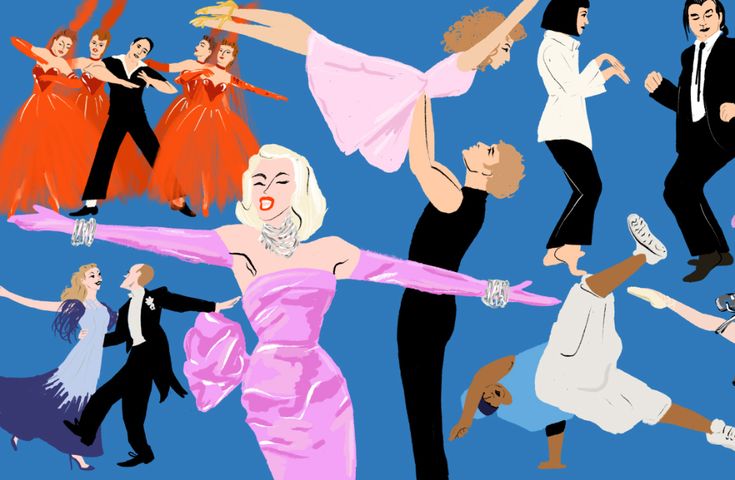 It is also grace, ease of movement, royal posture, self-confidence and good mood. And the coach will help with everything else.
It is also grace, ease of movement, royal posture, self-confidence and good mood. And the coach will help with everything else.
“Both 20 and 50 years old is a great age to start dancing,” says Alan Mambetov. - Therefore, you should not be afraid to go to classes if you had no experience and physical training before. The main desire! Of course, the sooner a person begins to train the body, the sooner a habit will begin to form, coordination will appear, the sooner he will master one or another dance direction. But even as an adult, you can do it. Some take a year. And someone has six months.
Alan advises you to decide on the direction before buying a ballroom pass.
“You can watch a lot of videos on the Internet, but you will understand if dancing is right for you or not only after you try to master it. If it doesn't work, don't force yourself! Look for yours. Moreover, there are a great many directions, ”explains Alan.
Dancing is not just beautiful. It is also grace, ease of movement, royal posture, self-confidence and good mood Photo: PRODANCE For example, breaking is not suitable for adult dancers without experience - the dance is traumatic, it requires high physical fitness and strong bones.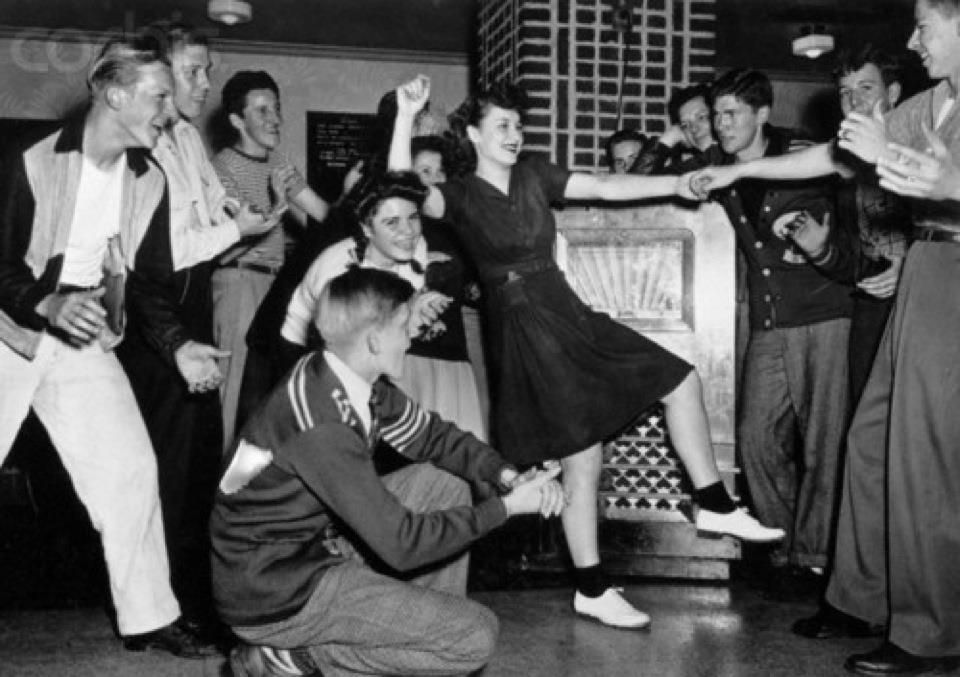 At the same time, for example, vogue will be ideal - an eccentric, stylish and expressive direction. Distinctive features of the dance are fast hand movements, mannered gait, smooth rotations. Salsa is also a good choice. By the way, focus on the music. It is unlikely that you can dance hip-hop if you do not like these rhythms.
At the same time, for example, vogue will be ideal - an eccentric, stylish and expressive direction. Distinctive features of the dance are fast hand movements, mannered gait, smooth rotations. Salsa is also a good choice. By the way, focus on the music. It is unlikely that you can dance hip-hop if you do not like these rhythms.
Dancing is not fitness
Dancing can seriously change a person's body. The dancer's movements will become smooth, and the muscles of the whole body will tone up, but dance will not replace fitness.
“Dancing is a good cardio workout, but dancing is no substitute for a full workout,” says Alan. “If you want to make your muscles more prominent, then you need to add a pool, a gym ... after all, dance is more about freedom of movement, coordination, acceptance of your body.”
But what if you want to achieve freedom, but it is difficult to overcome yourself and come to the gym?
“It's actually quite a common problem,” says the choreographer.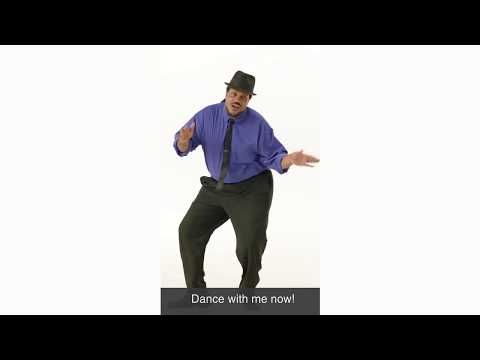 - A person wants to dance, but is afraid to seem clumsy, ridiculous. Many feel uncomfortable in their body, although the complexion does not play a role - in my practice there were people who even sent to a fitness bikini, but they moved much worse than donuts. The body needs to be loved, accepted, and then it will become easier to dance. Classes in a group and with an experienced coach will help to liberate yourself. The first times will be difficult, but with each new lesson it will become easier. There is a great example of this in my practice. And not even one. For example, one of my students is a 60-year-old artist-restorer, who in just six months not only learned to dance from scratch, but also began to participate and win in dance battles. After all, the main thing is desire.
- A person wants to dance, but is afraid to seem clumsy, ridiculous. Many feel uncomfortable in their body, although the complexion does not play a role - in my practice there were people who even sent to a fitness bikini, but they moved much worse than donuts. The body needs to be loved, accepted, and then it will become easier to dance. Classes in a group and with an experienced coach will help to liberate yourself. The first times will be difficult, but with each new lesson it will become easier. There is a great example of this in my practice. And not even one. For example, one of my students is a 60-year-old artist-restorer, who in just six months not only learned to dance from scratch, but also began to participate and win in dance battles. After all, the main thing is desire.
By the way
- In St. Petersburg there is the largest dance hall in Europe without columns.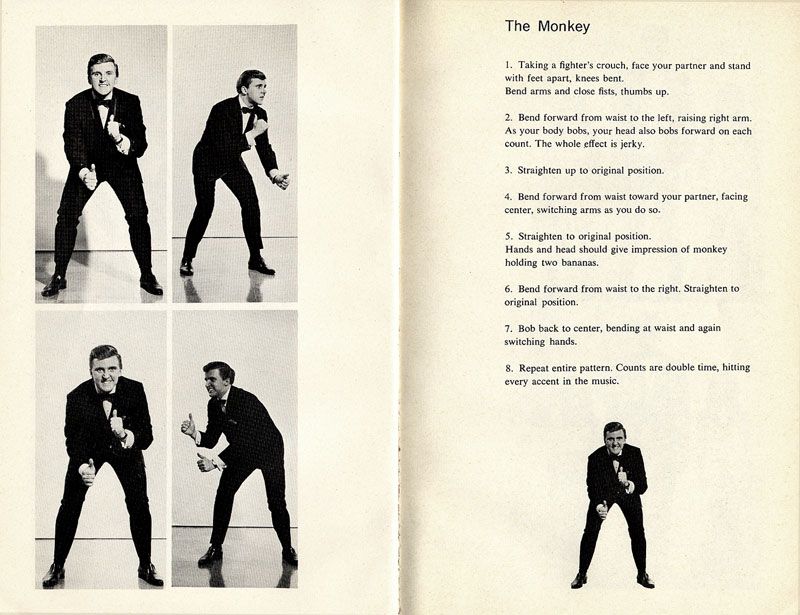
- There is an International Dance Day in the world. It is celebrated on April 29th.
- Sirtaki dance was invented in 1964 for a movie. But he fell in love with the Greeks so much that he became one of the symbols of the country.
- Stockholm has a whole museum dedicated to dance.
- The longest dance lasted 123 hours and 15 minutes. It was performed by Indian dancer Kalamandalam Hemalente . After that, the girl got into the Guinness Book of Records.
See also:
- "The main thing is to find yourself." Oleg Gazmanov - about music, sports and the song "Squadron" →
- "Daddy taught me not to worship people." Singer Yolka about songs and show business →
- "I am an energy person." Natasha Koroleva about the stage, family and "Yellow Tulips" →
show Dancing on TNTshow DancingDancingTime to dance
Next article
You may also be interested in
- The triumph of dance and technology.
